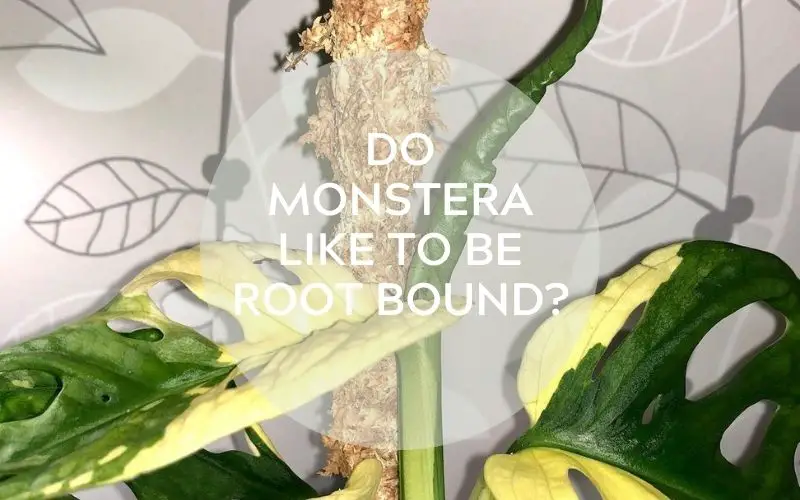“Root-bound” occurs when a plant’s root system outgrows the available space in the pot or container. While some plants thrive in this state, others do not. Do Monsteras like to be pot-bound?
A limited container restricts the roots’ ability to grow and expand, leading to several detrimental effects on their health. Let’s unravel the mysteries about the Monstera root bound and discuss proper treatments to save your tropical ornamentals from potential harm.
In This Article
What Is Root Bound?
Plants cultivated in pots will ultimately run out of room as their roots develop.
When roots try to escape via any drain holes in the pots, plants become root bound (also known as ‘pot bound’). They may try to escape out of the soil and cover the pot’s lip in some situations. In almost every case, the roots will begin to develop in overlapping rings that follow the container’s inner walls.
As roots take over the container’s interior area, there is less capacity for soil to store water, which can lead to root death. Allowing root-bound plants to continue to develop in this manner would not only limit their growth but will also likely result in their death.

Do Monstera Deliciosa Like To Be Root Bound?
Not really. Monstera’s roots can tolerate a small pot, but the plant prefers ample room for its roots to expand. The lack of space hinders the root from access to nutrients and water. It then develops into a tangled and intricate root system and puts pressure on the pot.
If it continues to be tightly packed and fills up the container, it can face various issues and show signs of stress, like yellow leaves, leaf drops, slow or stunted growth, and an increased risk of pest infestations.
Remember that Swiss cheese plants feature large, leathery leaves and a vigorous growth habit. Given its size and growth rate, providing adequate space for its roots to absorb essential nutrients is important. To ensure optimal growth, repot the plant into a slightly larger container every two to three years or when you notice any indicators of outgrowing.
Related Post: White spots on Monstera leaves? Causes and treatment
Signs Of Monstera Root-Bound
Root Coming Out Of The Drainage Hole
One of the most visible signs of root bound is the presence of roots filling up the drainage hole. The roots extend beyond the container in search of more water and nutrients. Otherwise, the photosynthesis process can’t occur effectively.
When I left my Swiss cheese plant unattended for a month, I noticed its aerial roots grew unusually dense compared to the first repotting time. This development may be an adaptive mechanism for accessing nutrients in a limited space.
You Notice Yellow Or Brown Crispy Leaves
The plant’s foliage serves as a window into its health. If you notice yellow or brown leaves, root-bound roots may be to blame, along with other factors like irregular watering. Limited contact area with soil leads to ineffective root activity and dehydration.
As a result, its reduced biological function becomes evident through its appearance. The leaves start to yellow, gradually browning and curling, typically starting with the outer edges. If not addressed promptly, their beautiful leaves might drop soon.
Your Plant Grows Slowly (Or Even Stop)
Due to the lack of nutrients, the growth rate slows down or, worse, comes to a halt. The plant may exhibit stunted growth or deformities despite receiving adequate light. This is because sunlight alone cannot supply the essential minerals, such as boron, magnesium, or nitrogen, necessary for producing healthy leaves.
Your Potting Mix Dries Out Frequently
Despite the regular watering routine of my Monstera plant twice a week when the humidifier was on, I was surprised to find the soil unexpectedly dry after two days, and there were some roots protruding from the drainage hole. This prompted me to investigate further, and upon removing the plant from its pot, I discovered a tangled mess like spaghetti noodles.
The lesson is that frequent drying of the potting mix indicates the root-bound issue. Act promptly, or else the roots will fill the pot while the soil gets washed away with each watering, exacerbating the issue.
How To Inspect The Monstera Root System
Once one of the above signs occurs, give the root ball a thorough check. But before doing so, the first step is to provide your plant with cool glasses of water. This is like the first aid for dry and fragile roots.
I recommend you do this a day before testing the roots so that the soil and roots have enough moisture. Then, check around the drainage holes. If you have roots stuck inside, use a sharp pair of scissors to cut them out.
Now, let’s begin the main task. Place the pot on its side and gently pull the Monstera out. My containers are made of stones, so I only have to tap around the pot’s wall gently to loosen the soil; you can also apply this trick to ceramic or terracotta pots. If you are working with plastic pots, a slight squeeze would do.
It is important to exert moderate force and avoid squeezing the stem. Once the plant is removed, closely examine the root system.
How To Fix A Root Bound Monstera
Prune Back The Roots
Consider pruning the roots if you do not want to repot your Swiss cheese plant. This allows you to keep your current pot and saves a lot of effort. Just take Monstera out of the container and cut off the roots at the bottom with sharp scissors.
Remember to leave thick roots intact since they are crucial in nutrient transport. Repeat the root pruning until the root ball fits in the container, but never trim more than ⅓ of the root system.
Then, rinse the roots in warm water and return the plant to the pot. You should not resume your regular watering schedule until the soil is dry. Your Monstera may suffer from stress and shock, so it needs time to recover.
On the downside, this measure only works once. When signs of root-bound conditions reappear, it’s the plant’s way of saying: “Hey, I need a new home!” Insisting on using the old pot makes the plant more susceptible to diseases.
Repotting
Biologists recommend Monstera deliciosa repotting in early spring or before blooming periods. The process is simple since you only need to take the plant out of the pot as instructed above and then put it back in a larger container.
However, it would help to remove ⅓ of the old potting mix to minimize stress. At the same time, do not bury the plant too deeply in the new container, and remember to water it immediately.

Split A Root-Bound Monstera
When my Monstera seems to overgrow, I always split it into smaller sections to revitalize it and introduce new “residents” in my tropical garden. Separating the plant can only be successful when you ensure each section comes with its own root system and growth potential. So, how to separate a Monstera? Here is my way to do it:
First, you need to water the soil the day before to reduce the stress that occurs later. Remove the plant from the soil as instructed above and observe for growth points. Use sharp scissors to cut through roots or stem junctions.
Make sure the new plants have roots and leaves to grow. Focus on these criteria instead of achieving large numbers. Eventually, put these plants in suitable containers and care for them properly. My Monstera plants grew healthy after a few weeks, even though their leaves initially turned yellow.
How To Prevent Monstera From Root-Bound
As mentioned, it’s best to repot your Swiss cheese plants every 2-3 years to keep the root-bound problems at bay. Botanists recommend that gardeners prepare a new container that is 1-2 inches larger in width and depth than the current one to accommodate the growth of your ornamentals.
It is worth noting that a pot that is too large can kill your plant even faster than the rot-bound issue. A large container is a recipe for waterlogging, leading to root rot in your plan.
If your Monsteras have entered the mature stage, there’s no need to repot them regularly. However, it would help if you kept fertilizing them to keep the soil fertile. The most popular mixture is garden soil and peat moss or coco peat in a 1:1 ratio. You can also buy orchid or succulent mix at local stores if you don’t have time to mix it.
From my experience, I usually add a portion of perlite on the top layer. These substances stimulate root growth and improve soil structure. Their biggest benefit is maintaining optimal year-round ventilation, insulation, and drainage.
FAQs
Is It Bad For Monstera To Be Root Bound?
Yes. To some extent, Monstera plants can tolerate being root-bound, but it is generally not ideal for long-term health and growth.
Should Monstera Root Be Above The Soil?
Monsteras do have aerial roots due to their natural climbing habit. However, when the roots are exposed above the soil, this indicates certain health issues.
Conclusion
Finding an accurate answer to whether Monstera likes to be pot-bound requires a nuanced understanding of their growth habits and preferences. With their robust root systems, these plants can withstand a cramped living space, but they will thrive better when they have room to expand. With ample space and proper care practices, Monstera plants will continue to grace your indoors with tropical elegance.


